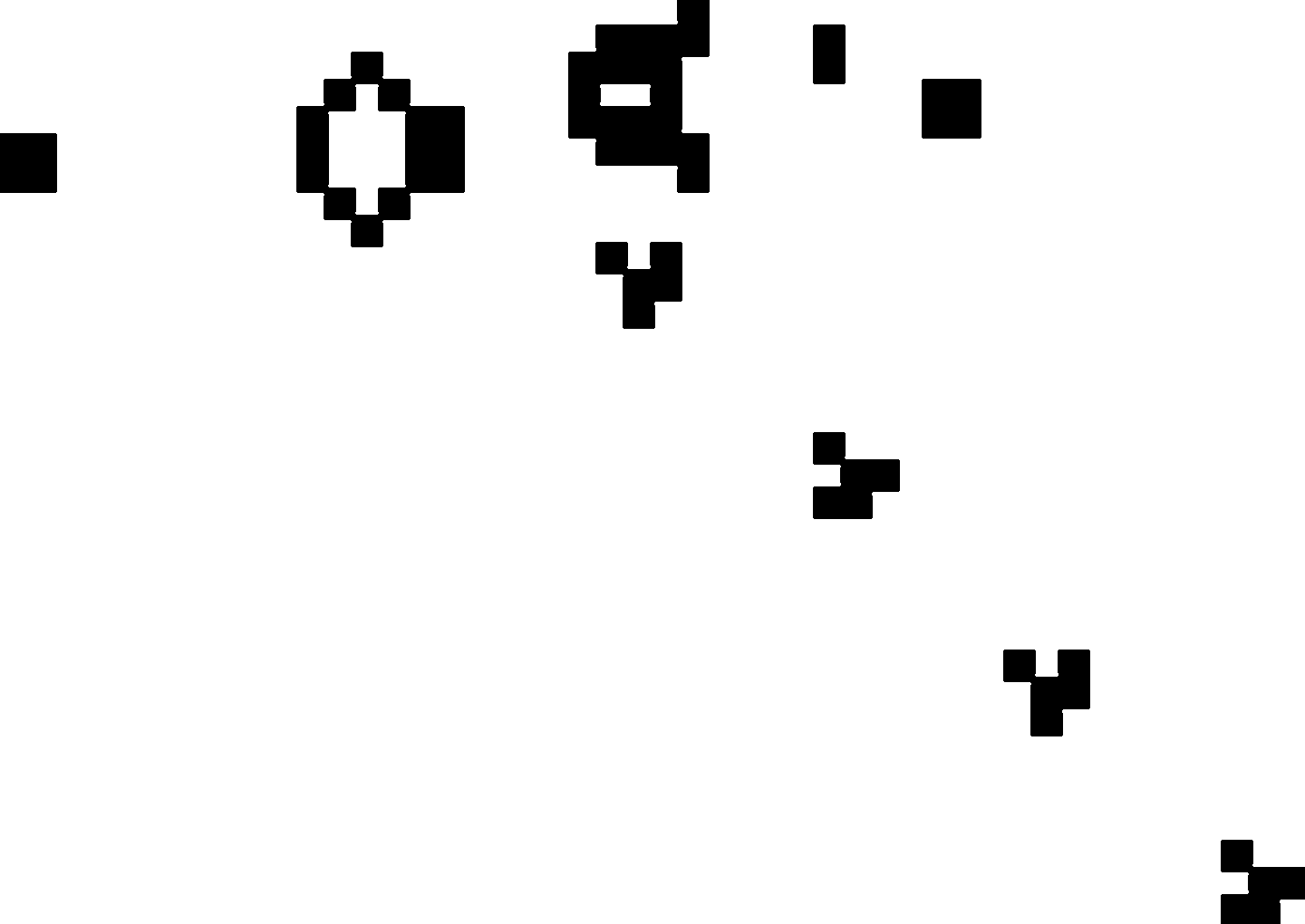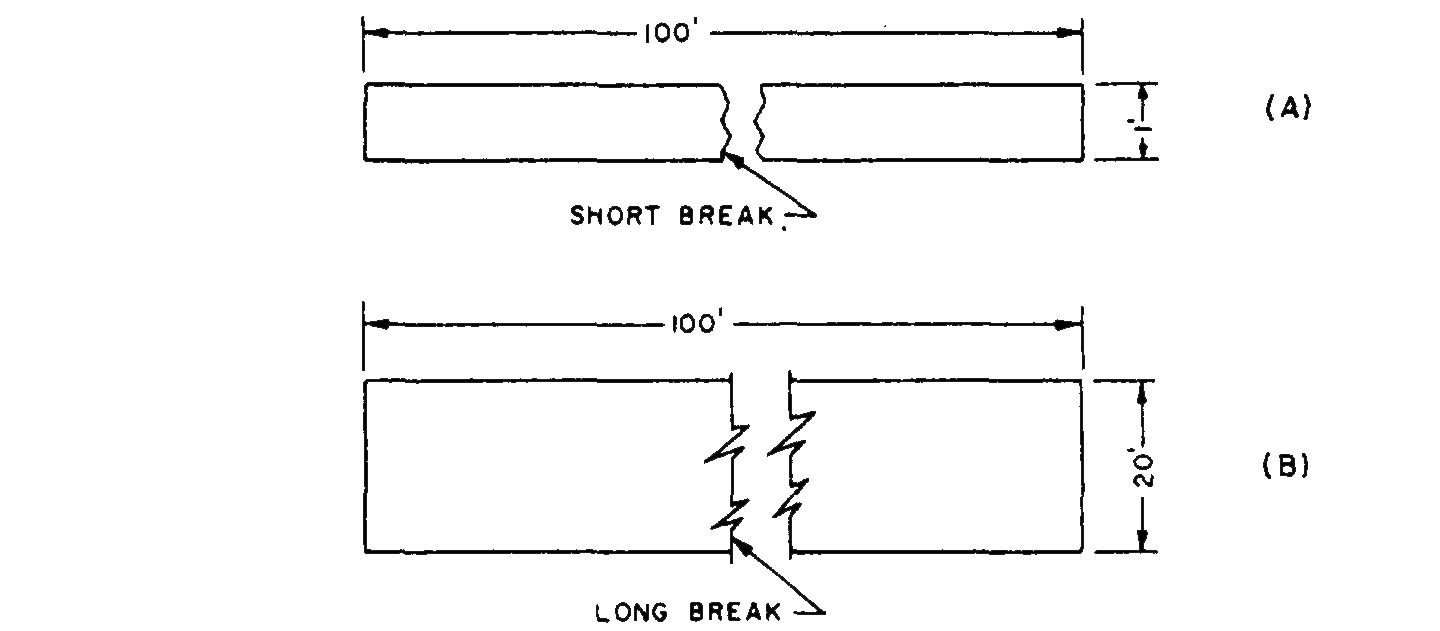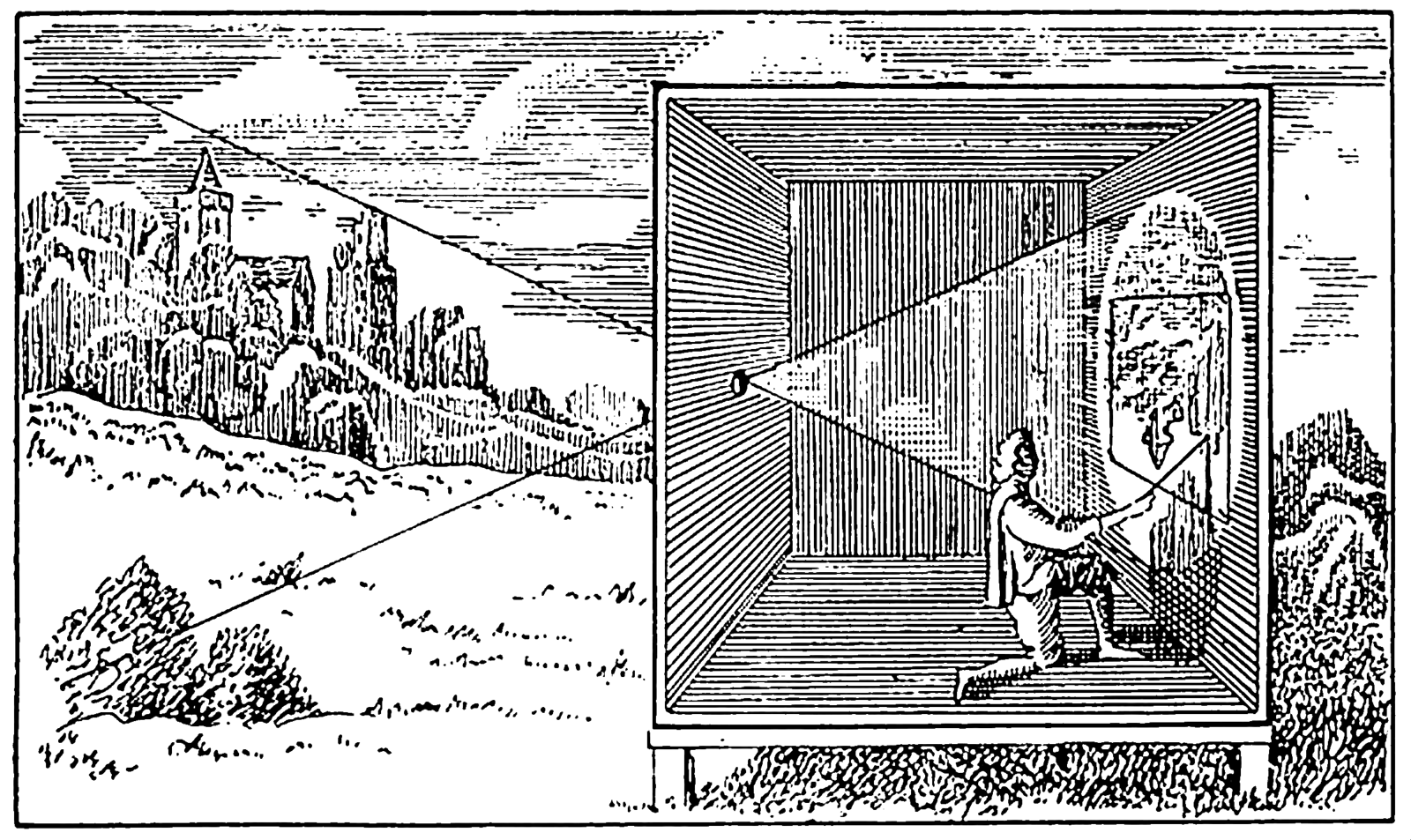Computer models are essential for understanding any number of processes from the weather to economic collapse, and they are used in a variety of ways. Weather simulations, for instance, predict when hurricanes will develop, and when they will touch land. Other types of models focus less on prediction in practice and more on providing a theoretical understanding the workings of a particular aspect of the world. They are used to “give form” to ideas about the world, as Mary Morgan describes, for example by visualizing outcomes or simplifying a chaotic system into a few key aspects and simulating how they interact.1
But as the recent financial crisis demonstrated, the ways that models are implemented can exceed their actual predictive power. Models often end up being applied in areas far beyond those for which they were originally designed, and they can be used in practical settings without serious thought about their theoretical underpinnings and assumptions. Indeed, as Donald MacKenzie argues in his book on financial models, the widespread use of models can even reshape the social processes that they are designed to depict. The Black-Scholes-Merton model, one method for determining the future prices of stock options, for example, changed the ways that traders think about markets, and ultimately reshaped the ways that those markets work.2
In recent years, researchers have ramped up efforts to expand upon the narrow assumptions of many models of social and urban processes. The approaches taken by complexity theory, perhaps most widely known from its association with fractals and the mathematical study of chaos, are an important part of this process. Agent-based models (ABMS) are one of the main types of such complex models.
ABMs play a variety of theoretical and experimental roles in the computational study of society. In some cases, they might function as simplified thought experiments, for example to understand residential decisions in cities. In others, they provide the basis for large-scale and high-powered computer simulations of business or transportation patterns in urban economies. Across their many uses, ABMs allow researchers to study how broader social and economic patterns emerge from the many small-scale interactions of individual actors.
While ABMs are increasingly influential as an alternative way to model society, the social aspects of such models require far greater attention than they’ve so far received. Such attention is crucial, both so that the models don’t reinforce social injustice and so that the models themselves are able to reach their full explanatory potential. To date, the mathematical imaginations that many complex models draw on have been far more open and creative than the social imaginations they invoke, with a few notable exceptions.3
The wider under-theorizing of the social implications of social models stems in part from the fact that expertise in the humanities and social theory tends to be undervalued in the public sphere.4 A broader lack of attention to theories of society today is comparable to the ways that heterogeneous social actors, which ABMs are specifically designed to incorporate, were themselves long undervalued in computer modeling. So the hesitancy to incorporate theories of social heterogeneity is an oversight, especially for models like ABMs, whose developers actively seek a more thorough and relevant engagement with society.
Segregation as Individual Choice: The Schelling Model
To get at the social ramifications of computational models of society, it’s worthwhile to explore some alternative formulations and interpretations of a simple ABM that has been influential in the development of further computer models of cities in both urban studies and complexity economics. The Schelling model of urban segregation is a precursor to contemporary ABMs that, although originally formulated in the late 1960s, continues to inform contemporary efforts to expand upon the assumptions of macroeconomic models.5 It is designed to show how micro-scale preferences, such as a slight inclination for living with actors who are similar to themselves, can result in macro-scale patterns, such as a broadly segregated map.
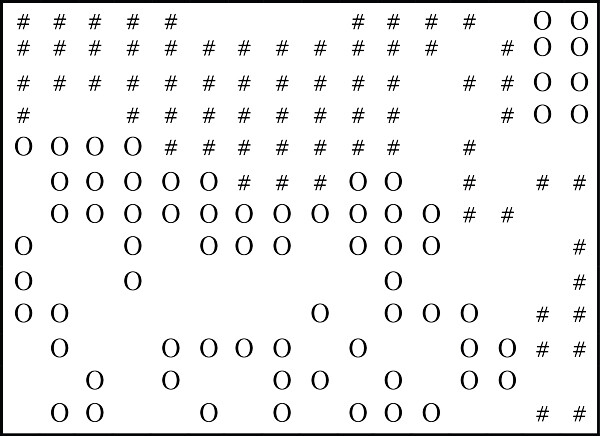

One possible output of the Schelling model, a representation of segregated neighborhoods. The symbols are arranged in a grid, but the grid lines have been omitted for clarity. Recreated by the author from Schelling.
Like related models, such as John Horton Conway’s Game of Life and cellular automata more broadly, ABMs are often represented by different pieces or colors on a grid. They resemble (and are inspired by) traditional board games like checkers and the game of Go. They can be referred to as “zero-player games” because they remove the uncertainty of player decisions, since the moves are determined beforehand by set preferences among the different players, or classes of agents.6 So the ultimate configuration of the board, if a stable one is reached, depends upon its initial set up (which is usually random), the strength of the preferences or other assigned variables, and the rules for each move, as well as any random variables that come into play during each turn.
Schelling himself provided several iterations of his model, and it has been broadly used both directly and as the inspiration for a multitude of subsequent ABMs.7 Here I return to one of its simplest forms, which was explored in depth by Schelling himself in 1971. It was also later adapted for broader use in the freely available NetLogo modeling software.
The main point of models like Schelling’s is that an overall pattern of neighborhood segregation can emerge from the individual decisions that agents make to move from one home to another. In this version of Schelling’s model, there are two types of agents, represented by #’s and O’s. Each agent has a home (grid square) and an immediate neighborhood (the agents in the eight adjacent squares).
Before running the model, the modeler can set the agents’ preference for how similar their immediate neighborhood must be. If their preference for percent of “similar” neighbors is not met, then the agent will move. For example, if the preference is 50%, then the agent will move if more than 4 of its 8 neighbors are of a type (O or #) different to its own. If the preference is 25%, then it will move if more than 2 of its 8 neighbors are of a different type. In each turn, or step in the model, all of the agents check their immediate neighborhood and move accordingly. If all of the agents are satisfied with their immediate neighborhood, then the model ends in the sense that no agents move and its overall grid becomes stable.
Formulated in this way, the Schelling model presents segregation as a result of individual choice, and suggests that all actors are equally powerful. In contrast, the model can be analyzed with respect to how, first, race, and second, nature are inflected through, but not reducible to, economic class. In light of a more heterogeneous social frame, the same model with the same result can lead to quite different conclusions.
These conclusions show how the interpretations of the model is overdetermined, in the sense that more than one adequate explanation is possible for the same results. But to date, only a narrow set of possible interpretations has been considered. In so doing, expanding the social frame challenges the core of Schelling’s argument that the model primarily demonstrates that macro patterns have their foundations in micro scale decisions of individual actors.
In addition to reinterpreting the model results, it is also possible to reimagine the model, taking into account aspects of legacies of racism and urban nature so that the model might more adequately address the deep heterogeneity of potential actors. This demonstrates that social complexity isn’t a sufficient excuse to justify the limited social imaginations evident in many models. Indeed, if broader social imaginations are employed in formulating such models, then their ultimate potential can be much broader and more relevant to society.
The point is not to single out the Schelling segregation model, however. Instead, Schelling’s account of segregation is useful in the sense that it is a relatively straightforward model, with clear social implications, and whose basic aspects can be readily understood. But like many ABMs, the segregation model works by assigning numerical values to specific preferences, such as that for living in a homogenous neighborhood. The source of those preferences, such as racism, is cut off from the model, and are presented as extraneous to its inner workings. It is especially interesting, then, that forces that aren’t even worthy of being given a value, forces that are framed as being outside the sphere of value, can come to challenge the fundamental conclusions drawn from the model itself.
The truths that models are said to prove cannot be separated from the stories told about those models.8 This suggests a need for greater acknowledgement of how the values and preferences assigned in models themselves have agency in terms of directing the ways that models are used and understood. Greater attention to how models are imbricated in the world their makers claim to represent requires more concerted attention to the value of historically and geographically specific people and social groups. It also demands further engagement with social theory. Such an engagement is necessary for economic models from complexity theory to become more than unwitting ideological tools for imposing the will of a group of agents who are relatively homogeneous compared with society more broadly: namely, economists and those who are influenced by them.
Redlining: Modeling Residential Racism
Schelling formulates his model in a way that includes segregation according to any type of difference, but as he was writing in the context of the movements for racial equality USA during the 1960s and 1970s, he includes an extended analysis of racial segregation. The model is often taken to focus upon race and, although less often so, economic class. Schelling also notes that his model does not allow for “organized action” on the part of either group, and that it “tells us little about the behavior that leads to, or that leads away from, particular outcomes.”9 He allows that preferences might differ between the two groups, although he does not explore this in detail.
Writing on tolerance, Schelling allows preferences to vary within groups (some whites are more tolerant than others), but group preferences are still equal between groups (if white tolerance varies, then black tolerance varies in an identical way).10 He also considers the dynamics moving into and out of pre-existing neighborhoods, but choice is based solely on how many residents there are of which group. Presenting segregation in this way allows Schelling to argue, and rightly so, that some segregation “processes may be passive, systemic, unmotivated but nevertheless biased.”
Even so, two things are particularly telling about Schelling’s framing of segregation in terms of the chosen behavior of more or less equal individuals, rather than the “organized action” of political groups. One is that it removes the racism from racial segregation in the United States. Most notably, his analysis removes one of the most enduring and telling dynamics of segregation from the picture: namely, all forms of coercion via racism, including systemic targeted violence against people of color in “white” neighborhoods, which has long been prevalent in the United States.11 Two is that this absence of coercion as a motivating factor is not explained within the model itself. For even without modification, the model can be read as supporting the hypothesis that segregation dynamics occur through active and coordinated exclusion.
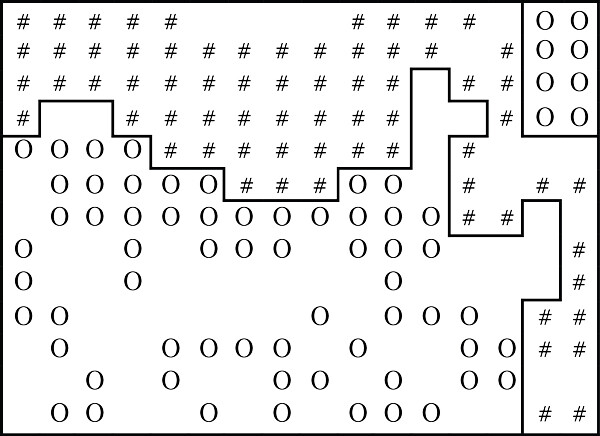

One possible output of the Schelling model, reinterpreted to account for racism, in the form of redlined districts, indicated by the interior black lines.
The Schelling model can also be read as an illustration of exclusion. Redlining is the practice whereby government and financial actors coordinated to prevent people of color, and African Americans in particular, from moving out of Black neighborhoods that are defined by boundaries that were depicted as red lines; hence the term “redlining.”12 Although it’s not an uncommon practice today, in the United States redlining dates back at least to the early 1900s. For example, as Austin Berg notes of 1930s Chicago, “Neighborhoods containing black residents were marked as Class D [the lowest mortgage class], regardless of black residents’ income and no matter how small a proportion of the area’s total population was black.” The Federal Housing Administration then granted no loans “for either purchasing or upgrading properties in these ‘redlined’ areas.”13
We could then say that O’s indicate the “white” neighborhood, and the interior black lines indicate the “red” boundaries which Black families, or #’s, were not allowed to cross. What is notable about redlining is that the neighborhoods were not necessarily bordered on the ground, so ostensibly anyone could move to any location, as in Schelling’s 1971 formulation of his model. However, privately mortgaged loans and related forms of insurance were systematically denied to Black people who applied for them in order to move within the red lines that defined the white neighborhood.
It is especially interesting, then, to reconsider the assignment of preferences in Schelling’s model in light of redlining as a form of coordinated racist political action (excluding people of color) that obscures itself by manifesting as discrete decisions (the denial of individual mortgages). Although in theory Schelling’s model would allow for different preferences between groups (such that, say, Blacks were more tolerant than whites), the model most often depicts the preferences as being equal between groups. So both groups would, for example, remain in place if no more than 30% of their immediate neighbors were from their “own” group. Yet this vacates cases like redlining where one group has explicit power over the other group’s apparent preferences.
In Schelling’s model, even when it is possible to set different preferences among groups, this only leads to segregation if both groups are at least a little intolerant. In cases where one group is 100% tolerant, for instance, then the neighborhood won’t become completely segregated regardless of the preference of the other group. (In this case, 100% tolerant means that, for example, the #’s won’t move no matter who their neighbors are, and will tolerate 100% of their neighbors being O’s.) The reason for this is that one group cannot explicitly force the other to move. So even if intolerant O’s attempt to move because they are surrounded by many #’s, as long as the #’s do not choose to move, then the O’s end up moving to “empty” squares, if there are any, or in cases where it’s permitted, just changing places with other O’s, and the overall degree of segregation on the board remains largely unchanged as the model is run.
Although the model doesn’t explicitly allow for one group to coerce the other to move, this dynamic is implicitly present in the way that preferences are formulated. For in terms of the model, the following two situations are equivalent: if O’s and #’s are both 50% tolerant and unable to force the other to move, and if O’s are 0% tolerant and can forcibly move #’s 100% of the time, whereas the #’s preferences have no effect (or alternately put, the #’s are 100% tolerant and are still unable to ever forcibly move O’s).
This can be seen by proceeding as follows: In Schelling’s model, as the model is run, O’s and #’s whose neighborhoods are too heterogeneous for their liking then move to more homogenous neighborhoods. Yet it makes no difference to the model if instead of the #’s moving because they want to live in homogenous neighborhoods, the intolerant O’s force or otherwise coerce the #’s to move because the O’s are determined to live in their own homogenous neighborhoods.
If we take our figure to be the initial state of a Schelling model, then it will remain unchanged as the model is run in either of the two situations: that both groups prefer to stay in their homogenous neighborhoods or one group prefers its homogenous neighborhood and it has the power to override the other group’s preference, according to their predilection for homogeneity. Therefore, if the Schelling model shows that segregated neighborhoods can arise out of slight individual preferences, it equally demonstrates that, in cases where only one group is intolerant of the other, segregation only results if that intolerant group can forcibly, and in a coordinated manner, displace members of the other group, regardless of the latter group’s preferences. Thus, in this interpretation, segregation only results if the intolerant group’s preferences have value over and above the preferences of the other, potentially more tolerant, group.
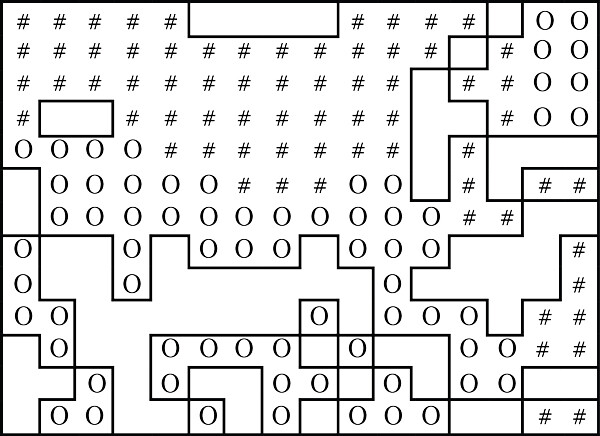

One possible output of the Schelling model, reinterpreted to account for nature, here represented as blank or empty areas that have been outlined in black.
Nature: The Value of “Empty” Squares
It is possible that Schelling left active coercion out of his model because he didn’t see its theoretical interest. However, recent scholarship has shown the pervasive influence of microaggressions in perpetuating racism and related effects like segregation.14 Thus political coercion can also be perpetuated through coordinated individual actions, but as just discussed, and as the Schelling model demonstrates, these preferences are only effective when they are combined with power over another group.
The example of redlining illustrates that Schelling’s model, instead of assigning equal power to the preferences of different groups, can be seen as quantifying, or assigning a numerical value to, the power imbalances between groups in cases of coercive discrimination. In addition, Schelling’s model can also be rethought in terms of understanding power imbalances that affect aspects of the model being recognized as a “group” from the beginning.
Considering the role of nature is particularly helpful for understanding the agency that the act of assigning numerical values, or in not doing so, can have in this and similar models. Important work has been done on the production of nature in relation to the urban, but here “nature” is used only for simplicity, and refers to the empty squares (non-built up, open, marginal, and/or possibly uninhabited areas) that agents move to when they do in the course of a model run.15
Schelling’s model requires the presence of at least some empty squares on the board (grid), because the rules require that only one agent occupies each square, and that grid squares consist of the full set of options for where agents can move. In other words, if the board were 100% filled, even if agents wanted to move, there would be nowhere for them to go. These empties (empty squares) therefore serve as the background on which the model is run. They are not agents in the model itself, because they are not assigned preferences or a marker, and they themselves cannot move. In terms of the model, they exist only to be filled (or not) by agents.
However, the empty squares do have a sort of agency, because their relative number shapes the outcome of the model. If the two sets of agents (#’s and O’s) have a strong (75%) preference for living in homogenous neighborhoods, and there are few empty squares, then after many runs the board devolves into two or more large, solid-color groups, and succeed in creating one of the most segregated boards possible. Conversely, if agents have a strong preference for homogeneity but there are many empty squares, then small, fully segregated communities tend to form, clustered around areas that were initially homogenous and isolated from each other via a buffer of empty squares.16
The empty squares matter precisely because they are not agents and do not have (recognized) preferences. It would be possible to modify the Schelling model to include three different groups of agents. However, no matter how many different groups there are, they still need “natural” or empty squares in order to move. These empty squares perform the role that nature played for many urban developers over the course of the twentieth century. They are depicted as a blank backdrop whose importance lies precisely in its supposed availability for occupation by some agent.17
Yet as scholars of urban nature and urban ecology have long argued, the natural areas of the city are anything but empty.18 In addition to diverse natural flora and fauna, many were and are occupied by indigenous communities, not to mention heterogeneous groups like homeless people or undocumented workers.19 The groups listed above may not be given official residence of the sort depicted in the segregation model. Their position is analogous to being present, but without being assigned any preference (a number that would indicate their level of tolerance). They simply aren’t counted or taken into consideration in the model’s calculation. Alternately, it could also be interpreted as if the groups are present, but are not allowed to legally occupy the square where they live, i.e. aren’t able to fill that square such that another agent couldn’t replace them at will.
In the previous section, I directly reinterpreted the conclusions drawn from the model by critiquing the way that the preferences of the model are interpreted. I then suggested that one group’s preference could actually be the partial or total result of coercion from the other group. Now I would like to indirectly reinterpret the models’ conclusions. I will cast one assumption of the model (available empty squares) in a different light in order
To demonstrate how reinterpreting the significance of empty squares changes the model’s implications, it is necessary to take a case where one group is fully tolerant (preference for 0% of its neighbors required to be from the same group as itself) while the other is fully intolerant (preference for 100% of its neighbors as being from the same group as itself). The tolerant group is happy no matter who its neighbors are, so in this scenario, agents in that group will stay put, no matter what. By contrast, depending on the amount of empty squares and initial configuration of the board, many agents in the intolerant group will be constantly on the move, in search of a square where all of their neighbors are members of the agents’ own group.
If empty squares are necessary when both groups of agents are on the move, then they are even more crucial when one group is happily tolerant and immobile. This provides a very different picture from segregation spontaneously arising among two groups. What it means is that if one group is 100% tolerant, then the other group can only attempt to segregate if it controls the agenthood of the groups in empty squares—namely, not through the direct coercion that then is incorporated into the model as the other group’s “preference,” but instead by fully preventing their preferences from being incorporated into the model at all.
An analogy to the politics of visibility and invisibility is useful here, for some groups have been coerced through stigmatization in ways that nonetheless cast them as at least partial agents. In contrast, others have been coerced by being refused the category of agency, much as nature was long depicted in colonial narratives as a passive frontier, a receptacle waiting to be inhabited. Often, this dual characterization is leveled at the same groups but at different times. So immigrants might be stereotyped as (negative) agents in arguments for border control, but then their neighborhoods might be demolished for being “disused” or “empty” slums.
Far from showing segregation as only the result of an individual choice or preference, here the model can be read as indicating that such a choice is predicated on first the erasure and then the occupation of the squares of other groups and/or natural areas, according to the whims of the intolerant agents whose choice of a square to move to is random.
In most instances of the model, the two groups have equal numbers of agents. But, even if intolerant agents were in the majority, without preferential access to empty squares, and as long as the other agents remain tolerant, then an intolerant group cannot result in a segregated map. This is doubly so if the so-called empty squares are incorporated into the model as agents, and if those agents are given their “own” squares. But the required presence of “empty” squares suggests that they must be managed through, for example, laws of the commons, so that they are not subject to capricious occupation.
Conclusion: The Stuff of Games
Taking the Schelling segregation model at face value supports conclusions far removed from those originally intended. An analysis in terms of the history of racism in the USA suggests that one modeler’s preference is another’s sublimated coercion. An analysis in terms of the role of nature in the city shows the important role that supposedly “empty” squares, and the communities who use them, play in the overall explanatory value of the model.
Throughout, the value of preference lies not only in its quantitative value or percentage. Rather, the simple giving of value has an agentive force all of its own, both when it is given, as in the first example of race, and when it is denied, as in the second example of nature. With this in mind, the focus on the value of preference demonstrates that both examples are also related to issues about economic class, although they are not reducible to class because they emerge, in this interpretation, from contexts of US racism and the colonial domination of lands conceived of as “empty,” including informal urban areas, those managed by indigenous communities, and/or those that consist primarily of habitats for non-human animals and plants.
Given the interest among critical social theorists for researching how historical legacies are perpetuated, Schelling’s model and other ABMs are particularly interesting because their outcomes depend in large part upon the initial conditions—in this case, the original setup of the board. In the Schelling model, the initial setup of the board is most often egalitarian, meaning that it is random. These issues are all the more pressing given the unequal historical legacies of most, if not all, cities in terms of both racism and class legacies like the ways that family wealth, including real estate, is passed down through generations.
Both of these examples of race and nature consist of a reanalysis of an existing version of the model. However, it is also possible to imagine extending the model for other areas of interest in social theory, although each extension again invokes specific types of politics, and could be interpreted in many different ways. Feminist scholars have focused on the role of unpaid labor, like much childcare and housework, in shaping the ways that women’s views and “preferences” were long omitted from debates.20
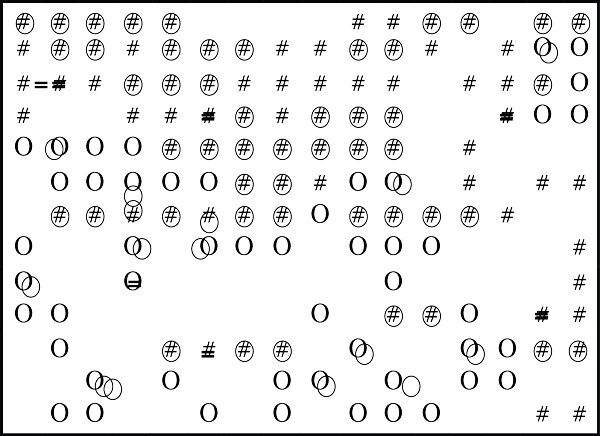

One possible output of the Schelling model, reinterpreted to allow for gender differences and household relationships, here indicated by allowing one agent to have multiple types, overlapping types of agents, and multiple agents per grid square.
In terms of the Schelling model and gender, we can see that for many, the decision to move is related in large part to job choice, which has often meant that heterosexual couples move in accordance with the location of a man’s job (a residential preference which may or may not have overlapped with his personal choice of residence). This is in no small part because of both overt sexism and, not unrelatedly, out of economic necessity, due to the unequal wages that many women historically earned, even in paid labor. In this case, then, the individual preference of the agent (here: the household) could be divided into two or more preferences that could be given different weights.
The Schelling model could also be expanded to take immigrant and refugee communities into account. In this case, however, it would be important not to fall into the trap of nativist discourse by only focusing on one board—namely, the board that represents the receiving country. Instead, Schelling could be run on two boards, representing two cities, related to one another.
In this migration model, the first board would represent a city in the country of the immigrants’ origin, and the configuration of the first group (locals and soon to become immigrants or refugees) would be shaped through the intervention of members of the second, in the form of developers, the military, and or colonial administrators. This would then push members of the first group to move to the second board, their destination city, and the second group’s home city. In this way, the dynamics between military intervention and migration could be analyzed as more than, as is too often the case particularly in the popular media, a local preference for segregation among immigrants, or as immigrants somehow impinging upon a mythically stable and homogenous society, rather than long being an economic necessity of a geographically extended and voluble one.
Sometimes the narrow social focus of models is justified with claims that society is too complex to develop critical models. In contrast, what these examples show is that there is no barrier, in terms of complexity, for providing reflection informed by social theory in the explanations derived from ABMs and other complex models. Indeed, as a type of elaborate thought experiment, models of society need not be overly complicated in order to be complex, or overly complex in order to be critically relevant.
If there is room for more breadth in the social imaginations of existing versions of Schelling’s model, then it can also be adapted quite widely in other areas that are of scholarly and practical importance for the study of urban societies. This does not mean that models should be used on a practical level, however. As many of the modelers themselves would allow, further research is necessary to enable them to become adequately complex and open, and to understand the role that such models perform in producing the societies their makers claim they represent.21 Nonetheless, reimagined models can be incredibly useful in pointing out the deficiencies of existing counts, and as a method for interrogating the practice of modeling itself. At the very least, revisiting Schelling helps to demonstrate that critical social research need not be anti-quantitative, and quantitative research need not be anti-critical theory.
Mary S. Morgan, The World in the Model: How Economists Work and Think (Cambridge, UK: Cambridge University Press, 2012), 20–27; Also see Mary S. Morgan and Marcel Boumans, “The Economy as a Hydraulic Machine,” in Models: The Third Dimension of Science, ed. Soraya de Chadarevian and Nick Hopwood (Stanford: Stanford University Press, 2004), 369–401.
Donald A. MacKenzie, An Engine, Not a Camera: How Financial Models Shape Markets, Inside Technology (Cambridge, MA: MIT Press, 2006).
Stephen Benard and Robb Willer, “A Wealth and Status-Based Model of Residential Segregation,” The Journal of Mathematical Sociology 31, no. 2 (March 22, 2007): 149–74; Li Yin, “The Dynamics of Residential Segregation in Buffalo: An Agent-Based Simulation,” Urban Studies 46, no. 13 (December 1, 2009): 2749–70; Ned Rossiter, “Logistical Worlds,” Cultural Studies Review 20, no. 1 (March 19, 2014): 53–76; Anand Sahasranaman and Henrik Jeldtoft Jensen, “Dynamics of Transformation from Segregation to Mixed Wealth Cities,” PLOS ONE 11, no. 11 (November 18, 2016).
In the popular media, this has been discussed for example by Derbyshire et al. Hawking vs. Philosophy (London: Institute of Art and Ideas), accessed March 15, 2017, https://iai.tv/video/hawking-vs-philosophy. and Goldhill “Why Are so Many Smart People Such Idiots about Philosophy?,” Quartz, March 5, 2016, ➝.
Thomas C. Schelling, “Models of Segregation,” The American Economic Review 59, no. 2 (1969): 488–93; “Dynamic Models of Segregation,” Journal of Mathematical Sociology 1, no. 2 (1971): 143–186.
Staffan Björk and Jesper Juul, “Zero-Player Games. Or: What We Talk about When We Talk about Players,” in The Philosophy of Computer Games Conference (Madrid, 2012).
Tim Rogers and Alan J. McKane, A Unified Framework for Schelling’s Model of Segregation, 2011, ➝; Benjamin Reh, Felix Aller, and Katja Mombaur, “A New Continuous Model for Segregation Implemented and Analyzed on Swarm Robots,” in Swarm Intelligence (International Conference on Swarm Intelligence, Springer, Cham, 2016), 28–39.
Soraya de Chadarevian and Nick Hopwood, eds., Models: The Third Dimension of Science (Stanford: Stanford University Press, 2004); MacKenzie, An Engine, Not a Camera; Morgan, The World in the Model.
Micromotives and Macrobehavior (New York: W. W. Norton, 1978), 166.
Micromotives and Macrobehavior, 155–66.
Sherrilyn Ifill, On the Courthouse Lawn: Confronting the Legacy of Lynching in the Twenty-First Century, 1 edition (Boston: Beacon Press, 2007); Amy Louise Wood, Lynching and Spectacle: Witnessing Racial Violence in America, 1890-1940, 1 edition (Chapel Hill: The University of North Carolina Press, 2011).
Yves Zenou and Nicolas Boccard, “Racial Discrimination and Redlining in Cities,” Journal of Urban Economics 48, no. 2 (September 1, 2000): 260–85; Laxmi Ramasubramanian, Geographic Information Science and Public Participation (Berlin: Springer-Verlag, 2008), ➝; Katharyne Mitchell and Sarah Elwood, “From Redlining to Benevolent Societies: The Emancipatory Power of Spatial Thinking,” Theory & Research in Social Education 40, no. 2 (April 1, 2012): 134–63.
Austin Berg, “How Government Paved the Way for Chicago’s Segregated Poverty,” May 25, 2016, ➝.
Derald Wing Sue, Microaggressions in Everyday Life: Race, Gender, and Sexual Orientation (Chichester, UK: John Wiley & Sons, 2010); Gloria Wong et al., “The What, the Why, and the How: A Review of Racial Microaggressions Research in Psychology,” Race and Social Problems 6, no. 2 (June 1, 2014): 181–200.
On marginal spaces in the city, see Ajay M. Garde, “Marginal Spaces in the Urban Landscape: Regulated Margins or Incidental Open Spaces?,” Journal of Planning Education and Research 18, no. 3 (March 1999): 200–210. On the production of nature in relation to the urban, see Neil Smith, Uneven Development: Nature, Capital and the Production of Space (Athens, USA: The University of Georgia Press, 2008).
This occurs because agent “happiness” depends on the percent of its neighbors who are the same kind as itself. So agents can be happy in small groups surrounded by empty squares, but on a full board there aren’t enough empty squares to surround each group, so those who are closest to the opposite color (i.e. in the margins between groups) have incentives to cluster in one large group, which reduces their exposure to the other group.
Depending on the initial configuration of the board, if the agents have the maximum preference for homogeneity (100%) and the board is either very empty or very full, then the board may never resolve into a stable pattern. This is because there simply aren’t enough empty squares, and too many agents on both sides are looking to move with each turn. The agents don’t think ahead to future turns, so what happens is that they move unendingly because they cannot find any squares where they are happy.
John Marzluff et al., eds., Urban Ecology: An International Perspective on the Interaction Between Humans and Nature (New York: Springer, 2008); Smith, Uneven Development: Nature, Capital and the Production of Space; Jens Lachmund, Greening Berlin: The Co-Production of Science, Politics, and Urban Nature (Cambridge, Mass: The MIT Press, 2013), 201.
This is not a haphazard association of emptiness with nature and also with particular groups in society. Many groups, including women and/or people of color, were long considered more “natural” in a denigratory fashion designed to suggest that they could not have independent reason or preferences.
J .K. Gibson-Graham, A Postcapitalist Politics (Minneapolis: University of Minnesota Press, 2006); J. K. Gibson-Graham, The End of Capitalism (As We Knew It): A Feminist Critique of Political Economy (Oxford, UK: Blackwell Publishers, 1996); Marianna E. Pavlovskaya, “Other Transitions: Multiple Economies of Moscow Households in the 1990s,” Annals of the Association of American Geographers 94, no. 2 (2004): 329–51.
MacKenzie, An Engine, Not a Camera; Evelyn Ruppert, “Not Just Another Database: The Transactions That Enact Young Offenders,” Computational Culture, no. 3 (November 16, 2013): 1–13.
Architecture and Representation is a project by Het Nieuwe Instituut, The Berlage, and e-flux Architecture.
Category
Subject
Architecture and Representation is a collaboration between Het Nieuwe Instituut, The Berlage, and e-flux Architecture.
